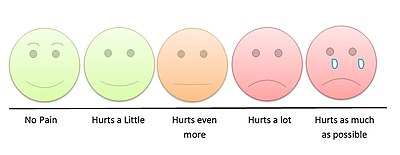User:Kyeager0307/sandbox
 | This is a user sandbox of Kyeager0307. A user sandbox is a subpage of the user's user page. It serves as a testing spot and page development space for the user and is not an encyclopedia article. |
 | This is a user sandbox of Kyeager0307. A user sandbox is a subpage of the user's user page. It serves as a testing spot and page development space for the user and is not an encyclopedia article. |
Pediatric Pain Management
[edit]Acute pain is common in children and adolescents as a result of injury, illness, or necessary medical procedures.[1] Chronic pain is also prevalent in approximately 15%-25% of children and adolescents, and may be caused by an underlying disease, such as sickle cell anemia, cystic fibrosis, rheumatoid arthritis, or cancer or by “functional” disorders such as migraines, fibromyalgia, or complex regional pain.[2] The focus of pediatric pain management is to reduce or eliminate the suffering associated with acute and chronic pain through nonpharmacologic or pharmacologic interventions as well as a combination of the two.
Assessment
[edit]
Pain assessment in children is often challenging due to limitations in the patient’s developmental level, cognitive ability, and their previous pain experiences. Therefore clinicians must observe physiological and behavioral cues exhibited by the child to make an assessment. Patient self-report, if possible, is the most accurate measure of pain. Self-report pain scales developed for young children involve matching their pain intensity to photographs of other children’s faces, such as the Oucher Scale, pointing to schematics of faces showing different pain levels (see image at right), or pointing out the location/s of pain on a body outline.[4] Questionnaires for older children and adolescents include the Varni-Thompson Pediatric Pain Questionnaire (PPQ) and the Children’s Comprehensive Pain Questionnaire, which are often utilized for patients with chronic or persistent pain.[4]
Nonpharmacologic Pain Management
[edit]Nonpharmacologic pain management includes interventions that do not involve the use of medication to treat pain and may be physical or cognitive-behavioral. Many caregivers choose to provide nonpharmacological treatment for children and adolescents because it carries minimal risk and is cost effective compared to pharmacological treatment. Nonpharmacologic interventions vary by age and developmental factors. Physical interventions to ease pain in infants include swaddling, rocking, or sucrose via a pacifier, whereas those for children and adolescents include hot or cold application, massage, or acupuncture.[5] Cognitive behavioral therapy (CBT) aims to reduce the emotional distress and improve the daily functioning of school-aged children and adolescents with pain through focus on changing the relationship between their thoughts and emotions in addition to teaching them adaptive coping strategies. Integrated interventions in CBT include relaxation technique, mindfulness, biofeedback, and acceptance (in the case of chronic pain). CBT is provided by therapists or at specialized pediatric centers and can be performed one-on-one, with other patients with a similar diagnosis, or with family.[6] Also important in pediatric pain management is caregiver support, and many therapists will hold sessions for caregivers to provide them with effective management strategies. [2]
Pharmacologic Pain Management
[edit]Acetaminophen, nonsteroidal anti-inflammatory agents, and opioid analgesics are commonly used to treat acute or chronic pain symptoms in children and adolescents, but a pediatrician should be consulted before administering any medication.[4]
References
[edit]- ^ American Academy of Pediatrics (2001). "The Assessment and Management of Acute Pain in Infants, Children, and Adolescents". Pediatrics. 108 (3): 793–797. doi:10.1542/peds.108.3.793.
{{cite journal}}: line feed character in|title=at position 47 (help) - ^ a b Weydert, JA (2013). "The interdisciplinary management of pediatric pain: Time for more integration". Techniques in regional anesthesia and pain management. 17 (2013): 188–194. doi:10.1053/j.trap.2014.07.006.
- ^ [abnormalchildpsychology.org "Abnormal Child Psychology"].
{{cite web}}: Check|url=value (help) - ^ a b c "Pediatric Pain Management" (PDF). American Medical Association. Retrieved March 27, 2014.
- ^ Wente SJK (2013). "Nonpharmacologic pediatric pain management in emergency departments: A sytematic review of the literature". Journal of Emergency Nursing. 39 (2): 140–150. doi:10.1016/j.jen.2012.09.011.
- ^ Zagustin TK (2013). "The role of cognitive behavioral therapy for chronic pain in adolescents". PM&R. 5 (8): 697–704. doi:10.1016/j.pmrj.2013.05.009.
